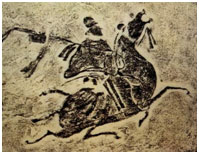Score Your Mission With The Art of War Strategies
As such, a victorious army ensures that it will win before going into battle. A defeated army engages in battle first and then look for victory.
SunTzu (544BC – 496BC), master strategist and author of Art of War.

Image source: http://commons.wikimedia.org/wiki/File:Touwtrekken.jpg
Previously, we explored crafting the mission statement as an organizational purpose (Sandra’s blog). We also looked at the importance of aligning organizational change initiatives to mission statements (Allison’s blog). This week we’ll use the Art of War as a foundation for mission critical strategies to secure wins. Sun Tzu’s Art of War (AoW) reveals military strategy and tactics for leaders to create opportunities or maneuver under ever-shifting conditions. Facing a similar need to address constant change, the business community has come to embrace Sun Tzu’s approach.
Consider the following common situations and how AoW insights can apply to your experience:
Have you ever started an activity fully motivated only to lose steam and drag yourself (or your team) to complete it?
Morale – Sun Tzu aptly summarized “At the beginning of a campaign, the spirits of the forces are high. As the campaign progresses, the spirits of the forces become sluggish and lethargy builds. Towards the end of the campaign, thoughts of closure will set in.” (AoW Chapter 7 Maneuvers)
Run the marathon not a sprint. Whether it is a yearly business-mission revision or a change development, we’re in it for the long-haul to build supporting operations. In other words, it’s a protracted campaign. Enthusiasm (ours or our team’s) fuels the early stages of activities as the prospects of glory or success energizes us. Gradually, that fervor may slacken and with it morale declines. Fatigue is often displayed through frustration and impatience. Towards the tail end of the program, folks wander off in search of rest and closure. To maintain momentum, consider:
- Shorter-term milestones/ checkpoints. Small or earlier achievements appeal to the mental state of closure by adding a sense of accomplishment to our team.
- Sharing the success. Immediate recognition promotes confidence. Showcase the positive results (of individual and collective efforts) as progress-to-date to encourage team members towards the next milestone.
Do you feel that working in a project filled with disorder and clamor, from those straining under the weight of (change) fatigue or work overload, is akin to fighting a lost cause?
Psychology – Sun Tzu would respond with “Use orderliness and stability to confront chaos and disorder. Use calmness and steadfastness to deal with noisiness and clamor.” (AoW chapter 7 Maneuvers)
Calm the storm. Drawing on orderliness to offset chaos, and calmness to counter noise is not as abstract as it sounds. SunTzu articulated clearly throughout AoW that one can still secure victory with a small but focused unit of resources. To achieve order, incorporate:
- Social touch-points. Identify the role models and/or subject-matter-experts within the ranks. Their opinions matter to those closer to the ground. Involve them as part of our communication plan to encourage or emotionally support other employees who show signs of stress.
- Scalable solutions. Assemble a task-force to create a scalable prototype of the program. Turn Impossible into Possible. Showing that the task is achievable will significantly reduce the psychological barriers (e.g. herd-mentality) that hinder progress.
Are you paralyzed by fixating on the difficulty of the task? Conversely, are you often carried away by opportunities to ignore inherent dangers?
Feasibility – Sun Tzu cautioned “The wise strategist always weigh and consider both favorable and unfavorable factors in his deliberations. By factoring the favorable factors, the mission can be accomplished with confidence. By factoring the unfavorable factors, the disasters and crisis can be averted.” (AoW chapter 8 Variations and Adaptability)
Turn adversity to advantage. Either paralysis or eagerness would be unwise. Careful deliberations account for:
- Favorable factors. Mulling over our weaknesses seldom raises confidence or our chances of victory. To accomplish challenges with greater ease, take stock of the skills and assets within the team to utilize as strengths. Determine what can be achieved when focusing on these strengths.
- Unfavorable factors. Diffuse group thinking by asking questions, such as: What could turn this situation negative? If this fails, what will cause the failure? Use worst-case scenarios or appoint a devil’s advocate to identify possible obstacles that may work against the plan. Map contingencies to preemptively mitigate possible crises.
Leaders, adapt these three AoW strategic pointers (on morale, psychology, feasibility) into your program planning and developments to achieve your advantages.

“The business environment is akin to battlegrounds” (Asian proverb). I’ll close this blog with a clip from Band of Brothers, The Breaking Point – Foy as a parallel to organizational programs we may have experienced. Can you associate the AoW pointers with the scenes?
Reference: AoW phrases adopted in part or in full from Sunzi, Wee C. H. (2003). Sun Zi Art of War: An Illustrated Translation with Asian Perspectives and Insights. Pearson Prentice Hall, wherein quotes are translated from the original text.
- The Confidence of Creative Learning Experiences - January 13, 2015
- Score Your Mission With The Art of War Strategies - December 9, 2014





